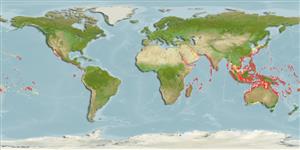Environment: milieu / climate zone / depth range / distribution range
Écologie
marin; saumâtre récifal; non migrateur; profondeur 1 - 50 m (Ref. 90102). Tropical; 25°C - ?; 36°N - 36°S, 24°E - 77°W
Indo-Pacific : Red Sea and East Africa (Ref. 4919) to Panama, north to southern Japan and the Hawaiian Islands, south to Lord Howe and Rapa islands. Eastern Pacific: Baja California and the Gulf of California to Panama (Ref. 9349, 11482).
Taille / Poids / Âge
Maturity: Lm ? range ? - ? cm
Max length : 50.0 cm TL mâle / non sexé; (Ref. 30874); poids max. publié: 2.0 kg (Ref. 40637)
Épines dorsales (Total) : 0; Rayons mous dorsaux (Total) : 10 - 11; Épines anales: 0; Rayons mous anaux: 10 - 11. This species is characterized by the following: The body is generally greenish-brown in color, the back, sides and caudal fin profusely speckled with white spots, and the belly marked with white bars. A single bent lateral line. Body with small spines except around snout and caudal peduncle. Each nostril with two fleshy solid tentacles. Restricted gill opening.
Inhabit outer reef slopes to depths of at least 50 m, inner reef flats and lagoons. Juveniles common in weedy areas of estuaries (Ref. 4919). Also found in coastal bays and estuaries, usually near rocky reef or on sand-stretches between reefs with low algae-rubble reef to about 20 meters depth, or in shallow with sparse seagrass growth (Ref. 48637). Benthopelagic (Ref. 58302). Usually solitary and territorial on sandy to rubble areas. Feed on fleshy, calcareous, or coralline algae, detritus, mollusks, tunicates, sponges, corals, zoanthid anemones, crabs, tube worms and echinoderms (Ref. 1602).
Life cycle and mating behavior
Maturité | Reproduction | Frai | Œufs | Fécondité | Larves
Myers, R.F., 1991. Micronesian reef fishes. Second Ed. Coral Graphics, Barrigada, Guam. 298 p. (Ref. 1602)
Statut dans la liste rouge de l'IUCN (Ref. 130435: Version 2024-1)
Menace pour l'homme
Poisonous to eat (Ref. 4690)
Utilisations par l'homme
Pêcheries: intérêt commercial mineur; pêche sportive: oui; Aquarium: Commercial
Outils
Articles particuliers
Télécharger en XML
Sources Internet
Estimates based on models
Preferred temperature (Ref.
123201): 23.7 - 29, mean 27.7 °C (based on 1504 cells).
Phylogenetic diversity index (Ref.
82804): PD
50 = 0.5000 [Uniqueness, from 0.5 = low to 2.0 = high].
Bayesian length-weight: a=0.03981 (0.02445 - 0.06482), b=2.82 (2.69 - 2.95), in cm total length, based on LWR estimates for this species & Genus-body shape (Ref.
93245).
Niveau trophique (Ref.
69278): 3.2 ±0.0 se; based on diet studies.
Résilience (Ref.
120179): Milieu, temps minimum de doublement de population : 1,4 à 4,4 années (Preliminary K or Fecundity.).
Fishing Vulnerability (Ref.
59153): Moderate vulnerability (40 of 100).
Nutrients (Ref.
124155): Calcium = 33.9 [14.1, 86.4] mg/100g; Iron = 0.555 [0.297, 1.204] mg/100g; Protein = 18.6 [16.4, 20.7] %; Omega3 = 0.113 [0.059, 0.212] g/100g; Selenium = 37.1 [18.8, 80.3] μg/100g; VitaminA = 38.4 [10.4, 141.7] μg/100g; Zinc = 1.13 [0.76, 1.70] mg/100g (wet weight); based on
nutrient studies.
